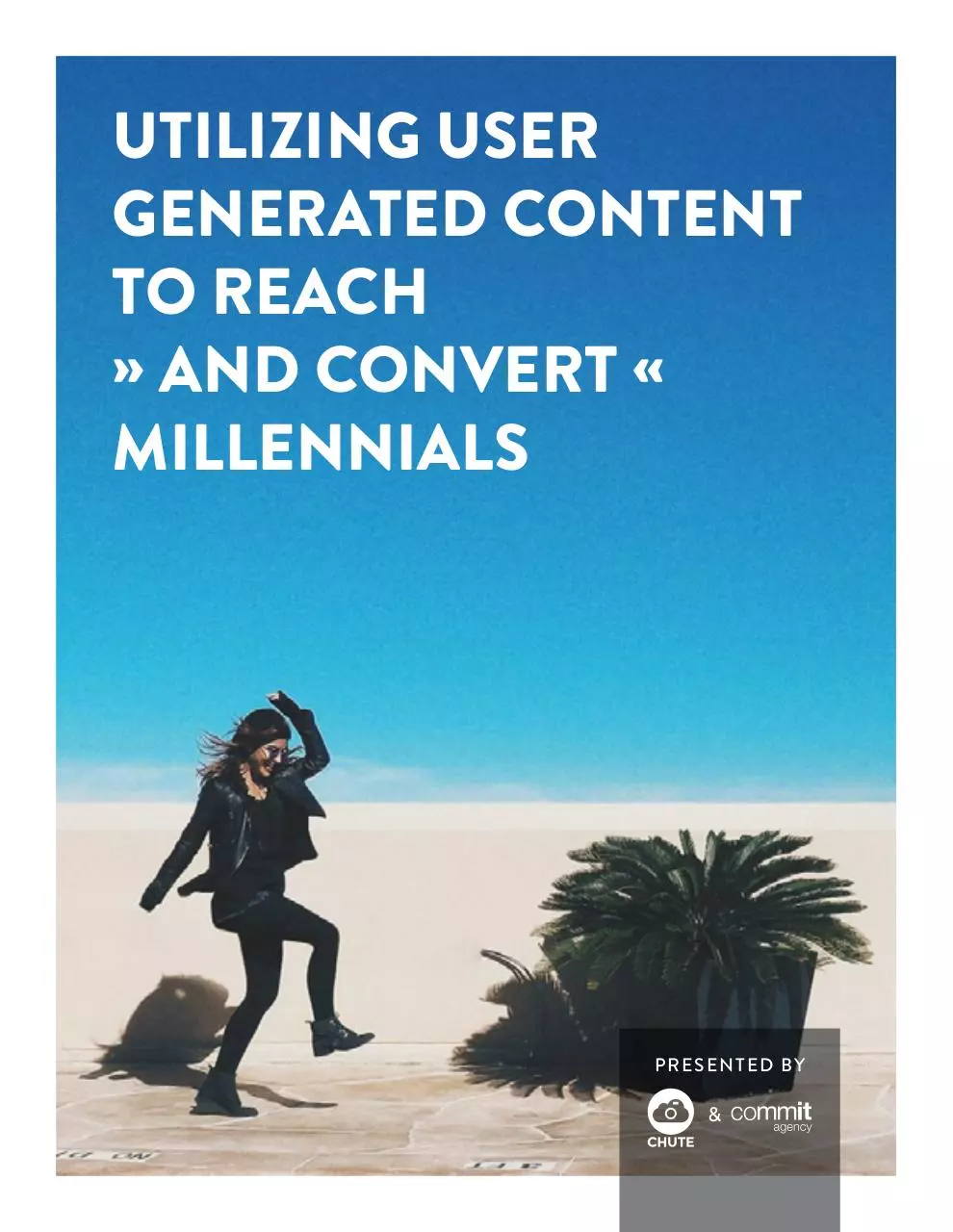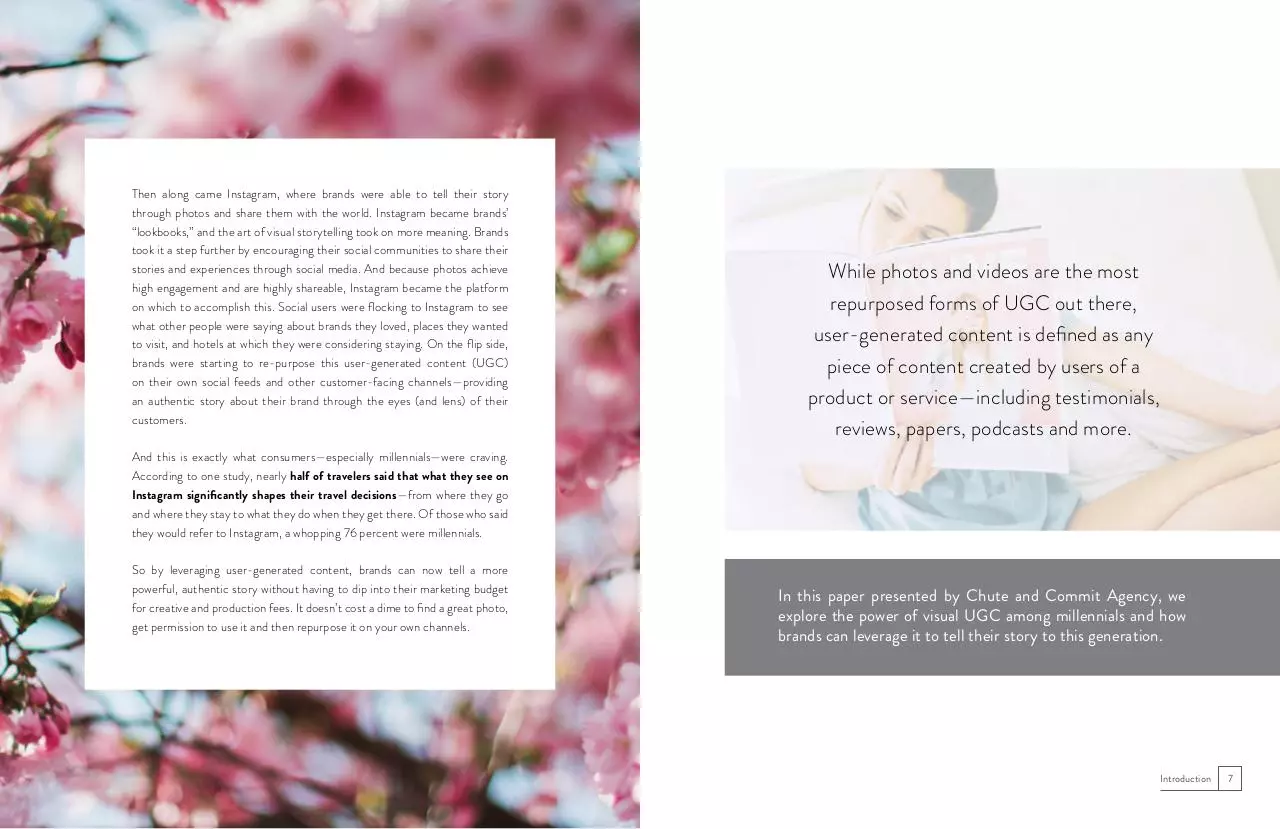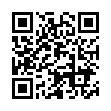COMMIT CHUTE UGC White Paper (PDF)
File information
This PDF 1.7 document has been generated by Adobe InDesign CC 2015 (Macintosh) / Adobe PDF Library 15.0, and has been sent on pdf-archive.com on 08/09/2016 at 18:54, from IP address 184.182.x.x.
The current document download page has been viewed 578 times.
File size: 10.06 MB (17 pages).
Privacy: public file





File preview
UTILIZING USER
GENERATED CONTENT
TO REACH
» AND CONVERT «
MILLENNIALS
PRESENTED BY
&
TABLE OF CONTENTS
4
Introduction
8
Part 1: User Generated Content & Millennials
12
Part 2: User Generated Content & Marketers
16
Part 3: Brands Doing It Right
28
Part 4: What Now?
29
Conclusion
Table of Contents
3
It wasn’t that long ago that brands had just a handful of tried-and-true options
to market their products and services. While these “traditional” advertising
channels like TV, radio, print and outdoor provided brands with the ability to
achieve high reach and capture the attention of a mass audience, they could
also be quite costly. Depending on the medium, reach, frequency, timing and
size of the ad, they could run into the thousands, hundreds of thousands or
even millions of dollars.
INTRODUCTION
Some brands can shell out that kind of dough, though, like those that spent
$4.5 million for a 30-second commercial during this year’s Super Bowl.
Most brands, simply, cannot. Plus, until recently, other options that offered
better targeting and impact were not available.
When advances in digital technology opened up new (and more affordable)
opportunities for brands to reach their target audiences, many companies
took advantage. From social media (organic and paid) to digital to mobile,
brands could now more tightly focus their advertising dollars on the prospects
that mattered most through highly targeted advertising. In the same vein,
advertisers were starting to pay more attention to the kinds of messages that
resonated most with their customers and prospects; ads that looked less like
ads and more like stories were infinitely more appealing and were, in turn,
converting prospects into customers.
Introduction
5
Then along came Instagram, where brands were able to tell their story
through photos and share them with the world. Instagram became brands’
“lookbooks,” and the art of visual storytelling took on more meaning. Brands
took it a step further by encouraging their social communities to share their
stories and experiences through social media. And because photos achieve
high engagement and are highly shareable, Instagram became the platform
on which to accomplish this. Social users were flocking to Instagram to see
what other people were saying about brands they loved, places they wanted
to visit, and hotels at which they were considering staying. On the flip side,
brands were starting to re-purpose this user-generated content (UGC)
on their own social feeds and other customer-facing channels—providing
an authentic story about their brand through the eyes (and lens) of their
customers.
While photos and videos are the most
repurposed forms of UGC out there,
user-generated content is defined as any
piece of content created by users of a
product or service—including testimonials,
reviews, papers, podcasts and more.
And this is exactly what consumers—especially millennials—were craving.
According to one study, nearly half of travelers said that what they see on
Instagram significantly shapes their travel decisions—from where they go
and where they stay to what they do when they get there. Of those who said
they would refer to Instagram, a whopping 76 percent were millennials.
So by leveraging user-generated content, brands can now tell a more
powerful, authentic story without having to dip into their marketing budget
for creative and production fees. It doesn’t cost a dime to find a great photo,
get permission to use it and then repurpose it on your own channels.
In this paper presented by Chute and Commit Agency, we
explore the power of visual UGC among millennials and how
brands can leverage it to tell their story to this generation.
Introduction
7
PART 1:
USER GENERATED
CONTENT &
MILLENNIALS
According to Pew, millennials (defined as those aged 19-35 as of 2016) have
already surpassed Baby Boomers as the largest living U.S. generation. These
millennials now number 75.4 million, and Pew projects the number will peak
in 2036 at 81.1 million due to immigration. While millennials continue to be
stereotyped as teens or young adults living with their parents, Accenture
found this group already has immense buying power—equalling $600 billion
annually with projections to hit $1.4 trillion by 2020.
These consumers have grown up with digital and social media, and a large
number can’t remember a world without Google. This has had a great
influence on their buying and research habits; they are innately more aware
of marketing and search out authentic stories to guide their decisions. Chute
saw this reflected in their research, discovering that 55% would be most
likely to purchase a product after getting to see someone like them use it.
Looking specifically at the youngest group of millennials, aged 19-24, this
number increases to 60%. And overall, 78% of millennials said they would
rather see photos of real customers over professional photos created by the
brand.
8
Part 1: User Generated Content & Millennials
How does this authenticity factor fluctuate based on industry? Chute gave
consumers a series of images and had them blindly choose the ones that most
inspired them to travel or purchase. For travel, 74% said the user-generated
images most made them want to visit the location shown. For electronics,
that jumps up to 83%; for fashion, 85% were inspired to look into a clothing
item after seeing it worn by a fellow consumer.
Not only are millennials looking to UGC to make real purchase decisions,
they’re also the ones creating this content. Across the board, 64% post to
social media to recommend a product or service at least once a month, and
that grows to 67% for 19- to 24-year-olds. And what do these consumers
want in exchange for their interaction? Not a whole lot—the majority said
they just want a comment or reply from the brand they’re posting about.
THE TOP SOCIAL PLATFORMS ON WHICH
MILLENNIALS FOLLOW BRANDS ARE:
74
36
24
23
YouTube
22
Snapchat
12
Tumblr
10
None
10
0
10
20
30
40
50
Percentage (%)
60
70
80
Of course, brands also are hoping consumers will want to follow their social
accounts. However, these consumers are still hard-pressed to follow brands.
While 74% said they follow a brand on Facebook, that number decreases
by half for the following platform with 36% saying they follow a brand on
Instagram.
However, this list shifts depending on the age of the millennials. Younger
millennials are much more likely across the board to follow brands, but their
top platforms (excluding Facebook) are Instagram, YouTube, and Snapchat.
Meanwhile, millennials aged 31-35 are much more unlikely to follow a brand
across the board, but their top platforms for doing so are more “traditional”
social media platforms: Instagram, Twitter and Pinterest.
Where Do Millennials Follow Brands?
83%
50%
YouTube
33%
Snapchat & Twitter
27%
20%
Tumblr
17%
None
3%
MILLENNIALS
19 - 24
YouTube
83%
33%
50%
71%
38%
31%
YouTube
27%
18%
None
13%
Snapchat & Tumblr
11%
71%
MILLENNIALS
25 - 30
31%
72%
Instagram & Twitter
26%
22%
None
11%
YouTube
11%
Snapchat
6%
Tumblr
6%
11%
11%
38%
22%
6%6%
MILLENNIALS 72%
31 - 35
26%
The question brands undoubtedly have are: what gets these people to follow
and not follow? Looking specifically at Instagram, Chute found that the
top thing millennials look for is a good theme or aesthetic. In fact, 57% said
this was the top factor when deciding to follow a brand—with that number
jumping up to 73% for 19- to 24-year-olds. In terms of unfollowing or just
choosing not to ever follow, 64% said the top factor was posting too often
and 55% said they get turned off by posts that look like ads or try too hard
to sell.
Instagram & Twitter
Part 1: User Generated Content & Millennials
11
PART 2:
USER GENERATED
CONTENT &
MARKETERS
Chute then talked to the marketers tasked with engaging these consumers
through digital media to see how user-generated content comes into play
for their executions. Currently, 78% are turning to user-generated content
for at least part of their marketing tactics. Why? Because marketers also
understand the value millennials place on authentic media; 87% said they use
user-generated content for that reason specifically.
Where are they implementing UGC? The top place is organic social posts—
especially on Instagram. However, many are also using it in paid social and
on their websites. Instagram is the top place these marketers are sourcing
user-generated content—unsurprising, considering the amount and caliber
of content that tends to be posted versus other social platforms.
WHERE ARE MARKETERS USING UGC?
Organic social media posts
80
Paid social posts
47
Websites
47
34
Live Events
23
Ads
17
Print media
15
6
Retail/eCommerce experiences
0
10
20
30
40
70
80
WHERE DO MARKETERS PUBLISH UGC?
81
77
62
23
Blogs
21
YouTube
17
Tumblr
6
10
20
30
40
50
Percentage (%)
Part 2: User Generated Content & Marketers
60
Percentage (%)
0
12
50
60
70
80
90
WHERE DO MARKETERS SOURCE UGC FROM?
87
72
54
YouTube
13
13
0
WHAT DO MARKETERS MOST WANT
TO BE AUTOMATED?
10
20
30
40
50
60
70
80
90
Percentage (%)
However, there’s more to UGC than
just content. Marketers also see
value in the data behind it; 45% said
they hope to find new influencers
with targeted niche audiences while
23% want to uncover demographic
and social media trends.
User-generated content also has its pain points.
Of marketers utilizing UGC, 57% said discovering
good content was their biggest hurdle. In fact,
when asked what part of UGC marketing they
most wish could be automated, the top pick was
discovering and managing their media. A huge
issue is that so many marketers are trying to
tackle UGC manually. There are tens of millions
of photos being shared daily on Instagram alone;
discovering the best on-brand content by using
their search bar is impossible to scale.
Lastly, the biggest worry for marketers around user-generated content is
the legalities. Rules and regulations haven’t adapted yet to this new form of
marketing. That’s why, of the marketers who aren’t yet using UGC, 57% said
legal concerns were their biggest hurdle. And of the marketers already using
UGC, 38% said copyright was their top concern.
HOW ARE MARKETERS
MANAGING THEIR UGC?
Manual, in-house
45
Software (like Chute)
25
Manual, agency
21
Other
9
0
10
20
30
Percentage (%)
40
1. Collecting and managing media
2. Content creation
3. Discovering influencers
4. Content discovery, creation and search
5. Mining consumer insights
6. Getting permission to use content
7. Performance measurement
8. Scheduling/publishing content
9. Approvals and governance
50
Again, the majority (53%) of marketers are doing this completely manually—
directly commenting on or messaging creators. Not only is this not scalable,
but it also leaves room for human error—something most legal teams
are going to be wary of allowing. Without access to software, that leaves
marketers with the less safe options of either using a branded hashtag and
hoping consent is implied or not getting rights at all.
Part 2: User Generated Content & Marketers
15
PART 3:
BRANDS
DOING IT RIGHT
While most brands would likely be able to source and repurpose
quality UGC, it is those brands within more experiential
industries—travel, food and lifestyle products—that seem to have
the pick of the litter when it comes to great photography that tells
their brand story in a creative, authentic way.
So, which brands are killing it with UGC? Let’s take a peek into
some of our favorites and tell you why they’re so great.
Download COMMIT CHUTE UGC White Paper
COMMIT_CHUTE_UGC_White_Paper.pdf (PDF, 10.06 MB)
Download PDF
Share this file on social networks
Link to this page
Permanent link
Use the permanent link to the download page to share your document on Facebook, Twitter, LinkedIn, or directly with a contact by e-Mail, Messenger, Whatsapp, Line..
Short link
Use the short link to share your document on Twitter or by text message (SMS)
HTML Code
Copy the following HTML code to share your document on a Website or Blog
QR Code to this page

This file has been shared publicly by a user of PDF Archive.
Document ID: 0000481633.